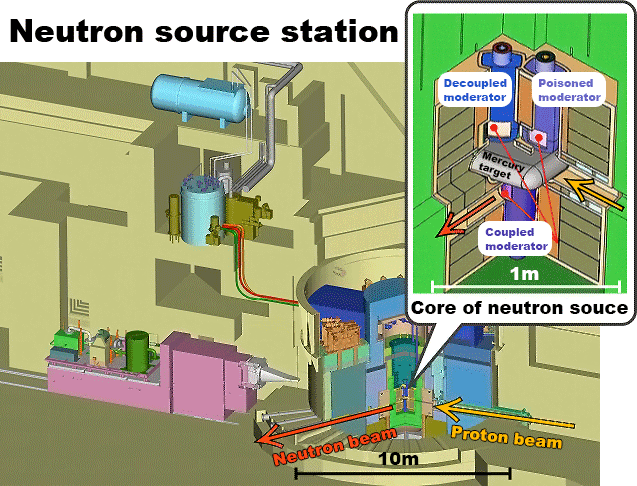Neutron・Muon sources
Here at MLF, we produce muon and neutron beams by collisions between the protons accelerated to near light-speeds (approximately 97%) by 3GeV synchrotoron at J-PARC and the nucleus of target materials: carbon for the muon target and mercury for the neutron target.
The muon target is installed along the proton beamline, which continues onward to the neutron target. A portion of the proton beam is used to generate pi mesons, which act as the source of muons; the remainder of the proton beam is used to generate neutrons at the neutron target located behind the muon target. The proton beam outputs are extremely high, with a maximum of 1 MW; so whole system are elaborated to minimize the damage of each targets. In addition, in order to produce high intensity muon and nutron beams, a number of cutting-edge technologies are interspersed along the transport pathway. With these innovative designs, MLF can provide the world's brightest muon and neutron beams to promote materials and life sciences.
Neutron souce system
The core of neutron souce system consists of the following comopnents: a mercury spallation target which produces high-energy neutrons by proton beam injection, three moderators to slow down neutron energy to be suitable for neutron scattering experiments, and reflectors to reflect neutrons efficiently to moderators.
Mercury target system
Mercury target system circulate 20 tons of liquid mercury into the target vessel, which enables efficient cooling capacity of the heat generated from the 1MW proton beam injection. Microbubble injection system is also installed in the target vessel to reduce the pressure waves, prolonging service time of the target vessel.
Moderator
Three moderators are set up alongside the mercury target. Circulating supercritical hydrogen in the moderator can efficiently decrease the neutron energy. Three characteristic moderators, coupled moderator (for high-intensity and low-resolution beam), decoupled moderator (for moderate-intensity and moderate-resolution beam) and posoned moderator (for low-intensity and high-resolution beam) provide unique neutron beams suitable for material research.
Reflector
Beryllium and iron blocks are set around the moderators as the reclectors. Most of "escaping" neutrons are reflected by the reflector back into the moderators to enhance the neutron beam intensity.

Overview of the muon source
Muon target
The muon target is located about 30-m upstream of the neutron target. The target is made of 2-cm thick graphite wheel, and consumes about 5% of the proton beam to generate a huge number of pions and eventually muons. The 5% beam loss corresponds to 50kW under 1-MW operation, and thus the counter measure is essential against the heat deposit and the radiation damage on the target itself and the surrounding devices.
The wheel-shape rotating graphite was adopted to mitigate the radiation damage and distribute it along the circumference. The development of the bearing is the key to successful operation. The inorganic solid lubricant (WS2) inserted between the bearing balls realizes the stable operation under high radiation field. In addition to this, the muon facility operation is supported by continuous R&Ds.
Muon beamline
The muon production target is surrounded by four muon beamlines (the D-, U-, S-, and H-lines) extending to the two experimental halls. The D-line is located in the hall No. 2. It has a modest acceptance for pion capture, and provides both surface and decay muons to experimental areas D1 and D2 through a 6-m solenoid as a pion-to-muon-decay section. The U-line is adjacent to the D-line. It consists of only axial focusing magnets: a large-acceptance rad-hard capture solenoid, a superconducting curved transport solenoid, and superconducting axial focusing magnets. Those magnets provide a high intensity surface muon beam to generate an “ultra-slow muon” (USM) beam. In the experimental hall No. 1, the S-line that is dedicated to provide surface muon beam is planned to have four experimental areas (S1–S4). At present, S1 was completed and under common use. The H-line is under construction toward the first beam deliver in 2021.